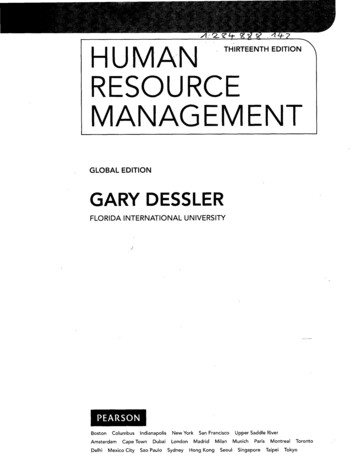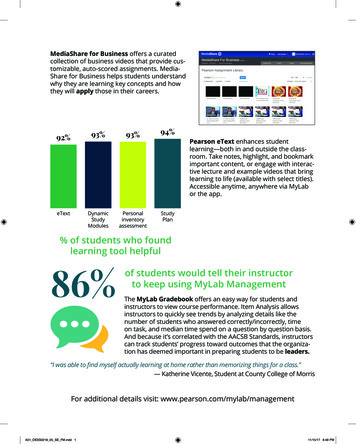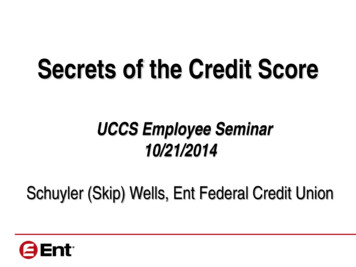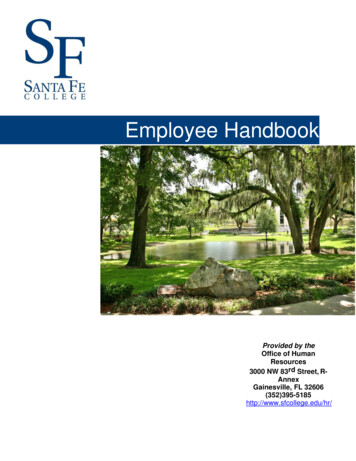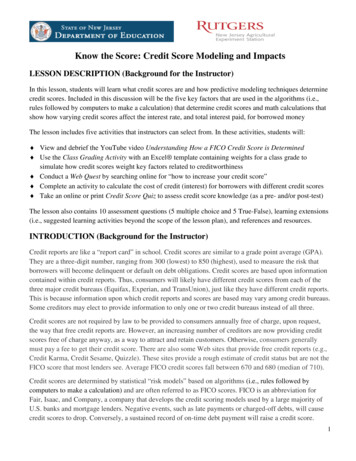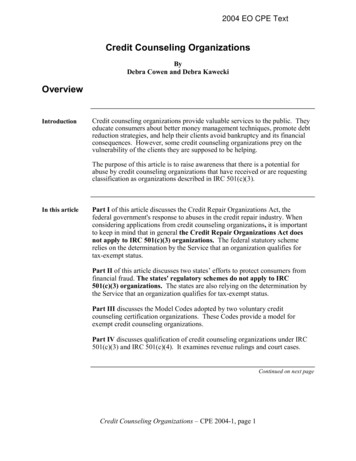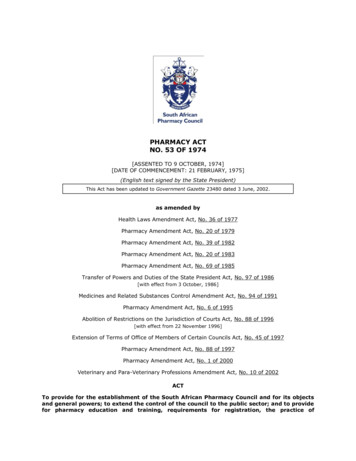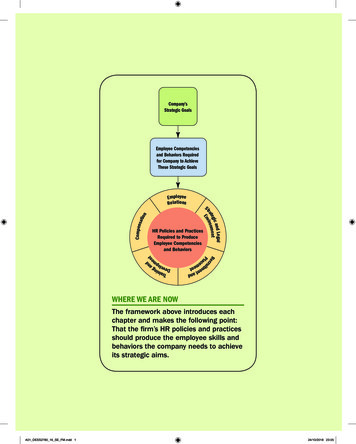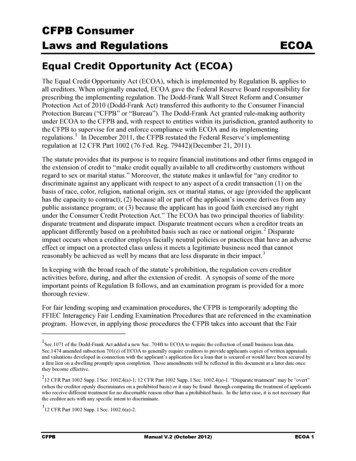
Transcription
Equal Credit Opportunity Act (ECOA)The Equal Credit Opportunity Act (ECOA), which is implemented by Regulation B, applies toall creditors. When originally enacted, ECOA gave the Federal Reserve Board responsibility forprescribing the implementing regulation. The Dodd-Frank Wall Street Reform and ConsumerProtection Act of 2010 (Dodd-Frank Act) transferred this authority to the Consumer FinancialProtection Bureau (“CFPB” or “Bureau”). The Dodd-Frank Act granted rule-making authorityunder ECOA to the CFPB and, with respect to entities within its jurisdiction, granted authority tothe CFPB to supervise for and enforce compliance with ECOA and its implementingregulations. 1 In December 2011, the CFPB restated the Federal Reserve’s implementingregulation at 12 CFR Part 1002 (76 Fed. Reg. 79442)(December 21, 2011).The statute provides that its purpose is to require financial institutions and other firms engaged inthe extension of credit to “make credit equally available to all creditworthy customers withoutregard to sex or marital status.” Moreover, the statute makes it unlawful for “any creditor todiscriminate against any applicant with respect to any aspect of a credit transaction (1) on thebasis of race, color, religion, national origin, sex or marital status, or age (provided the applicanthas the capacity to contract); (2) because all or part of the applicant’s income derives from anypublic assistance program; or (3) because the applicant has in good faith exercised any rightunder the Consumer Credit Protection Act.” The ECOA has two principal theories of liability:disparate treatment and disparate impact. Disparate treatment occurs when a creditor treats anapplicant differently based on a prohibited basis such as race or national origin. 2 Disparateimpact occurs when a creditor employs facially neutral policies or practices that have an adverseeffect or impact on a protected class unless it meets a legitimate business need that cannotreasonably be achieved as well by means that are less disparate in their impact. 3In keeping with the broad reach of the statute’s prohibition, the regulation covers creditoractivities before, during, and after the extension of credit. A synopsis of some of the moreimportant points of Regulation B follows, and an examination program is provided for a morethorough review.For fair lending scoping and examination procedures, the CFPB is temporarily adopting theFFIEC Interagency Fair Lending Examination Procedures that are referenced in the examinationprogram. However, in applying those procedures the CFPB takes into account that the Fair1Sec.1071 of the Dodd-Frank Act added a new Sec. 704B to ECOA to require the collection of small business loan data.Sec.1474 amended subsection 701(e) of ECOA to generally require creditors to provide applicants copies of written appraisalsand valuations developed in connection with the applicant’s application for a loan that is secured or would have been secured bya first lien on a dwelling promptly upon completion. Those amendments will be reflected in this document at a later date oncethey become effective.212 CFR Part 1002 Supp. I Sec. 1002.4(a)-1; 12 CFR Part 1002 Supp. I Sec. 1002.4(a)-1. “Disparate treatment” may be “overt”(when the creditor openly discriminates on a prohibited basis) or it may be found through comparing the treatment of applicantswho receive different treatment for no discernable reason other than a prohibited basis. In the latter case, it is not necessary thatthe creditor acts with any specific intent to discriminate.312 CFR Part 1002 Supp. I Sec. 1002.6(a)-2.
Housing Act (FHAct), 42 U.S.C. 3601 et seq., unlike ECOA, is not a “Federal consumerfinancial law” as defined by the Dodd-Frank Act for which the CFPB has supervisory authority. 4Applicability – 12 CFR 1002.2(e), 1002.2(f), 1002.2(j),1002.2(l), 1002.2(m), and 1002.2(q)Regulation B applies to all persons who, in the ordinary course of business, regularly participatein the credit decision, including setting the terms of the credit. The term “creditor” includes acreditor’s assignee, transferee, or subrogee who so participates. For purposes of discrimination ordiscouragement, 12 CFR 1002.4(a) and (b), the term creditor also includes a person who, in theordinary course of business, regularly refers applicants or prospective applicants to creditors, orselects or offers to select creditors to whom requests for credit may be made.Regulation B’s prohibitions apply to every aspect of an applicant’s dealings with a creditorregarding an application for credit or an existing extension of credit (including, but not limitedto: information requirements; investigation procedures; standards of creditworthiness; terms ofcredit; furnishing of credit information; revocation, alteration, or termination of credit; andcollection procedures). The regulation defines “applicant” as any person who requests or whohas received an extension of credit from a creditor and includes any person who is or maybecome contractually liable regarding an extension of credit. Under Regulation B, an“application” means an oral or written request for an extension of credit made in accordance withprocedures used by a creditor for the type of credit requested. “Extension of credit” means “thegranting of credit in any form (including, but not limited to, credit granted in addition to anyexisting credit [,] the refinancing or other renewal of credit.or the continuance of existing creditwithout any special effort to collect at or after maturity).” Because the ECOA and Regulation Bprohibit discrimination in any aspect of a credit transaction, a creditor violates the statute andregulation when discriminating against borrowers on a prohibited basis in approving or denyingloan modifications. Moreover, as the definition of credit includes the right granted by a creditorto an applicant to defer payment of a debt, a loan modification is itself an extension of credit andsubject to ECOA and Regulation B. Examples of loan modifications that are extensions of creditinclude, but are not limited to, the right to defer payment of a debt by capitalizing accruedinterest and certain escrow advances, reducing the interest rate, extending the loan term, and/orproviding for principal forbearance. 54In addition to potential ECOA violations, an examiner may identify potential violations of the FHAct through the course of anexamination. The FHAct prohibits discrimination in the sale, rental, and financing of dwellings, and in other housing-relatedtransactions, based on race, color, national origin, religion, sex, familial status (including children under the age of 18 living withparents or legal custodians, pregnant women, and people securing custody of children under the age of 18), and handicap(disability). The CFPB cooperates with the U.S. Department of Housing and Urban Development (HUD) to further the purposesof the FHAct. If a potential FHAct violation is identified, the examiner must consult with Headquarters to determine whether areferral to HUD or the U.S. Department of Justice and, if applicable, the creditor’s prudential regulator is appropriate.5See Federal Reserve Board Consumer Affairs Letter 09-13 (December 4, 2009)(http://www altr0913 htm).
Prohibited Practices – 12 CFR 1002.4Regulation B contains two basic and comprehensive prohibitions against discriminatory lendingpractices:A creditor shall not discriminate against an applicant on a prohibited basis regarding anyaspect of a credit transaction.A creditor shall not make any oral or written statement, in advertising or otherwise, toapplicants or prospective applicants that would discourage, on a prohibited basis, areasonable person from making or pursuing an application.Note that the regulation is concerned not only with the treatment of persons who have initiatedthe application process, but also with lender behavior before the application is even taken.Lending officers and employees must be careful to take no action that would, on a prohibitedbasis, discourage a reasonable person from applying for a loan. For example, a creditor may notadvertise its credit services and practices in ways that would tend to encourage some types ofborrowers and discourage others on a prohibited basis. In addition, a creditor may not useprescreening tactics likely to discourage potential applicants on a prohibited basis. Instructions toloan officers or brokers to use scripts, rate quotes, or other means to discourage applicants fromapplying for credit on a prohibited basis are also prohibited.The prohibition against discouraging applicants applies to in-person oral and telephone inquiriesas well as to written applications. Lending officers must refrain from requesting prohibitedinformation in conversations with applicants during the pre-interview phase (that is, before theapplication is taken) as well as when taking the written application.To prevent discrimination in the credit-granting process, the regulation imposes a delicatebalance between the creditor’s need to know as much as possible about a prospective borrowerwith the borrower’s right not to disclose information irrelevant to the credit transaction as well asrelevant information that is likely to be used in connection with discrimination on a prohibitedbasis. To this end, the regulation addresses taking, evaluating, and acting on applications as wellas furnishing and maintaining credit information.Electronic Disclosures – 12 CFR 1002.4(d)Disclosures required to be given in writing may be provided to the applicant in electronic form,generally subject to compliance with the consumer consent and other applicable provisions of theElectronic Signatures in Global and National Commerce Act (E-Sign Act) (15 U.S.C. 7001 et seq.).Rules for Taking Applications – 12 CFR 1002.5Regulation B permits creditors to ask for any information in connection with a credit transaction,so long as they avoid certain clearly defined areas set forth in 12 CFR 1002.5, which includeboth the specific prohibited bases of discrimination and certain types of information that oftenrelates to discrimination on a prohibited basis.
Applicant CharacteristicsCreditors may not request or collect information about an applicant’s race, color, religion, nationalorigin, or sex. Exceptions to this rule generally involve situations in which the information isnecessary to test for compliance with fair lending rules or is required by a state or federalregulatory agency or other government entity for a particular purpose, such as to determineeligibility for a particular program. For example, a creditor may request prohibited information:In connection with a self-test being conducted by the creditor (provided that the self-testmeets certain requirements) (12 CFR 1002.15);For monitoring purposes in relation to credit secured by real estate (12 CFR 1002.13; theHome Mortgage Disclosure Act, 12 U.S.C. 2801 (“HMDA”); Home Affordable ModificationProgram (“HAMP”)); orTo determine an applicant’s eligibility for special-purpose credit programs (12 CFR1002.8(b), (c) and (d)).Information about a Spouse or Former Spouse –12 CFR 1002.5(c)A creditor may not request information about an applicant’s spouse or former spouse exceptunder the following circumstances:The non-applicant spouse will be a permitted user of or joint obligor on the account. (NOTE:The term “permitted user” applies only to open-end accounts.)The non-applicant spouse will be contractually liable on the account.The applicant is relying on the spouse’s income, at least in part, as a source of repayment.The applicant resides in a community property state, or the property upon which theapplicant is relying as a basis for repayment of the credit requested is located in such a state.The applicant is relying on alimony, child support, or separate maintenance income as a basisfor obtaining the credit.
Inquiries Concerning Marital Status –12 CFR 1002.5(d)(1) and 1002.5(d)(3)Individual CreditWhen an applicant applies for individual credit, the creditor may not ask the applicant’s maritalstatus. There are two exceptions to this rule:If the credit transaction is to be secured, the creditor may ask the applicant’s marital status.(This information may be necessary to determine what would be required to gain access tothe collateral in the event of default.)If the applicant either resides in a community property state or lists assets to support the debtthat are located in such a state, the creditor may ask the applicant’s marital status. (Incommunity property states, assets owned by a married individual may also be owned by thespouse, thus complicating the availability of assets to satisfy a debt in the event of default.)Joint CreditWhen a request for credit is joint (made by two or more individuals who will be primarily liable),the creditor may ask the applicant’s marital status, regardless of whether the credit is to be securedor unsecured, but may use only the terms “married,” “unmarried,” and “separated.” Thisrequirement applies to oral as well as written requests for marital status information. ‘‘Unmarried’’may be defined to include divorced, widowed, or never married, but the application must not bestructured in such a way as to encourage the applicant to distinguish among these.Alimony, Child Support, or Separate Maintenance Income –12 CFR 1002.5(d)(2)A creditor may ask if an applicant is receiving alimony, child support, or separate maintenancepayments. However, the creditor must first disclose to the applicant that such income need not berevealed unless the applicant wishes to rely on that income in the determination ofcreditworthiness. An appropriate notice to that effect must be given whenever the creditor makesa general request concerning income and the source of that income. Therefore, a creditor eithermust ask questions designed to solicit only information about specific income (for example,“salary,” “wages,” “employment,” or other specified categories of income) or must state thatdisclosure of alimony, child support, or separate maintenance payments is not required.Residency and Immigration Status – 12 CFR 1002.5(e)The creditor may inquire about the applicant’s permanent residence and immigration status in theUnited States in determining creditworthiness.
Rules for Evaluating Applications – 12 CFR 1002.6General RuleA creditor may consider any information in evaluating applicants, so long as the use of theinformation does not have the intent or the effect of discriminating against an applicant on aprohibited basis. Generally, a creditor may not:Consider any of the prohibited bases, including age (providing the applicant is old enough,under state law, to enter into a binding contract) and the receipt of public assistance;Use child-bearing or child-rearing information, assumptions, or statistics to determinewhether an applicant’s income may be interrupted or decreased;Consider whether there is a telephone listing in the applicant’s name (but the creditor mayconsider whether there is a telephone in the applicant’s home); orDiscount or exclude part-time income from an applicant or the spouse of an applicant.Systems for Analyzing CreditRegulation B neither requires nor endorses any particular method of credit analysis. Creditorsmay use traditional methods, such as judgmental systems that rely on a credit officer’s subjectiveevaluation of an applicant’s creditworthiness, or they may use more-objective, statisticallydeveloped techniques such as credit scoring.Credit Scoring SystemsSection 1002.2(p) of Regulation B prescribes the standards that a credit scoring system mustmeet to qualify as an ‘‘empirically derived, demonstrably and statistically sound, credit system.’’All forms of credit analysis that do not meet the standards are automatically classified as‘‘judgmental’’ systems. This distinction is important because creditors that use a ‘‘demonstrablyand statistically sound’’ system may take applicant age directly into account as a predictivevariable, 6 whereas judgmental systems may do so only to determine a pertinent element ofcreditworthiness or to favor an elderly applicant.Judgmental Evaluation SystemsAny system other than one that is empirically derived and demonstrably and statistically sound,is a judgmental system (including any credit scoring system that does not meet the prescribedtechnical standards). With limited exception, such a system may not take applicant age directlyinto account in evaluating creditworthiness. The act and the regulation permit a creditor toconsider the applicant’s age for the purpose of evaluating other applicant information that has a6This applies provided that the age of an elderly applicant is not assigned a negative factor or value.
demonstrable relationship to creditworthiness. 7 Additionally, in any system of evaluatingcreditworthiness, a creditor may consider the age of an elderly applicant to favor the applicant inextending credit.Rules for Extensions of Credit – 12 CFR 1002.7Section 1002.7 of Regulation B provides a set of rules proscribing certain discriminatorypractices regarding the creation and continuation of credit accounts.Signature RequirementsThe primary purpose of the signature requirements is to permit creditworthy individuals(particularly women) to obtain credit on their own. Two general rules apply:A creditor may not require a signature other than the applicant’s or joint applicant’s if underthe creditor’s standards of creditworthiness the applicant qualifies for the amount and termsof the credit requested.A creditor has more latitude in seeking signatures on instruments necessary to reach propertyused as security, or in support of the customer’s creditworthiness, than it has in obtaining thesignatures of persons other than the applicant on documents that establish the contractualobligation to repay.When assessing the level of a creditor’s compliance with the signature requirements, examinersshould consult with the Examiner-in-Charge if any questions arise.Special-Purpose Credit Programs – 12 CFR 1002.8The ECOA and Regulation B allow creditors to establish special-purpose credit programs forapplicants who meet certain eligibility requirements. Generally, these programs target aneconomically disadvantaged class of individuals and are authorized by federal or state law. Someare offered by not-for-profit organizations that meet certain IRS guidelines, and some by forprofit organizations that meet specific tests outlined in 12 CFR 1002.8.Examiners are encouraged, if an issue arises regarding such a program, to consult with Headquarters.Notifications – 12 CFR 1002.9A creditor must notify an applicant of action taken on the applicant’s request for credit, whetherfavorable or adverse, within 30 days after receiving a completed application. Notice of approvalmay be expressly stated or implied (for example, the creditor may give the applicant the creditcard, money, property, or services for which the applicant applied).Notification of adverse action taken on an existing account must also be made within 30 days.7Judgmental systems may consider the amount and probable continuance of income. A planned reduction in income due toretirement may, for example, be considered.
Under at least two circumstances, the creditor need not comply with the 30-day notification rule:The creditor must notify an applicant of adverse action within 90 days after making acounteroffer unless the applicant accepts or uses the credit during that time.The creditor may not have to notify an applicant of adverse action if the application wasincomplete and the creditor sent the applicant a notice of incompleteness that met certainrequirements set forth in 12 CFR 1002.9(c).Adverse Action Notice – 12 CFR 1002.9(a)(2)A notification of adverse action must be in writing and must contain certain information,including the name and address of the creditor and the nature of the action that was taken. Inaddition, the creditor must provide an ECOA notice that includes the identity of the federalagency responsible for enforcing compliance with the act for that creditor. This notice isgenerally included on the notification of adverse action. The creditor must also either provide theapplicant with the specific principal reason for the action taken or disclose that the applicant hasthe right to request the reason(s) for denial within 60 days of receipt of the creditor’s notification,along with the name, address, and telephone number of the person who can provide the specificreason(s) for the adverse action. The reason may be given orally if the creditor also advises theapplicant of the right to obtain the reason in writing upon request.Incomplete Applications – 12 CFR 1002.9(c)When a creditor receives an incomplete application, it may send one of two alternativenotifications to the applicant. One is a notice of adverse action; the other is a notice ofincompleteness. The notice of incompleteness must be in writing and must specify theinformation the creditor needs if it is to consider the application; it must also provide areasonable period of time for the applicant to furnish the missing information.Applications Submitted Through a Third Party –12 CFR 1002.9(g)When more than one creditor is involved in a transaction and adverse action is taken withrespect to the application for credit by all the creditors involved, each creditor that took suchaction must provide a notice of action taken. The notification may be given by a third party;however, the notice must disclose the identity of each creditor on whose behalf the notice isgiven. If one of the creditors approves the application, the creditors that took adverse actionneed not provide notification.Notification to Business Credit Applicants –12 CFR 1002.9(a)(3)The notification requirements for business credit applicants are different from those forconsumer credit applicants and are more extensive if the business had gross revenues of
1,000,000 or less in the preceding fiscal year. Extensions of trade credit, credit incident to afactoring agreement, and similar types of credit are subject to the same rules as those that applyto businesses that had gross revenues of more than 1,000,000.Generally, a creditor must comply with the same notification requirements for business creditapplicants with gross revenues of 1,000,000 or less as it does for consumer credit applicants.However, the creditor has more options when dealing with these business credit applicants. First,the creditor may tell the business credit applicant orally of the action taken. Second, if thecreditor chooses to provide a notice informing the business credit applicant of the right to requestthe reason for action taken, it may, rather than disclose the reason itself, provide the notice at thetime of application. If the creditor chooses to inform the applicant of the right to request areason, however, it must provide a disclosure with an ECOA notice that is in retainable form andthat gives the applicant the same information that must be provided to consumer credit applicantswhen this option is used (see 12 CFR 1002.9(a)(2)(ii)). Finally, if the application was madeentirely over the phone, the creditor may provide an oral statement of action taken and of theapplicant’s right to a statement of reasons for adverse action.The notification requirements for business credit applicants with gross revenues of more than 1,000,000 are relatively simple. The creditor must notify the applicant of the action takenwithin a reasonable time period. The notice may be oral or in writing; a written statement of thereasons for adverse action and the ECOA notice need be provided only if the applicant makes awritten request within 60 days of the creditor’s notification of the action taken.Designation of Accounts – 12 CFR 1002.10(a)A creditor that furnishes credit information to a consumer reporting agency must designate:Any new account to reflect the participation of both spouses if the applicant’s spouse ispermitted to use or is contractually liable on the account; andAny existing account to reflect the participation of both spouses within 90 days afterreceiving a written request to do so from one of the spouses.If a creditor furnishes credit information to a consumer reporting agency, the creditor mustfurnish the information in the name of the spouse about whom the information was requested.Record Retention – 12 CFR 1002.12ApplicationsIn general, a creditor must preserve all written or recorded information connected with anapplication for 25 months (12 months for business credit) after the date on which the creditorinformed the applicant of action taken on an application or of incompleteness of an application.
Prohibited InformationA creditor may retain information in its files that it may not use in evaluating applications.However, the information must have been obtained inadvertently or in accordance with federalor state law or regulation.Existing AccountsA creditor must preserve any written or recorded information concerning adverse action on anexisting account as well as any written statement submitted by the applicant alleging a violationof the ECOA or Regulation B. This evidence must be kept for 25 months (12 months forbusiness credit).Prescreened SolicitationsThe 25-month retention rule also applies when a creditor makes an offer of credit to potentialcustomers. In such cases, the creditor must retain for 25 months following the date of thesolicitation:The text of any prescreened solicitation;The list of criteria the creditor used to select potential recipients of the solicitation; andAny correspondence related to complaints (formal or informal) about the solicitation.Rules for Providing Appraisal Reports – 12 CFR 1002.14Regulation B requires that creditors provide a copy of the appraisal report used in connectionwith an application for credit to be secured by a lien on a dwelling. A creditor may provide thecopy either routinely (whether or not credit is granted or the application is withdrawn) or upon anapplicant’s written request. If the creditor provides an appraisal report only upon request, it mustinform the applicant in writing of the right to receive a copy of the report.Incentives for Self-Testing and Self-Correction –12 CFR 1002.15A self-test, as discussed in 12 CFR 1002.15 of Regulation B, must meet two criteria. First, itmust be a program, practice, or study that a lender designs and uses specifically to determine theextent or effectiveness of its compliance with the regulation. Second, the results of the self-testmust create data or factual information that is otherwise not available and cannot be derived fromloan or application files or other records related to credit transactions. The findings of a self-testthat is conducted voluntarily by a creditor and that meets the conditions set forth in 12 CFR1002.15 are privileged against discovery or use by (1) a government agency in any examinationor investigation related to the ECOA or Regulation B or (2) a government agency or an applicantin any legal proceeding involving an alleged violation of the ECOA or Regulation B. Privilegedinformation includes the report or results of the test; data or other information created by the test;and any analysis, opinions, or conclusions regarding the results of the test.
To qualify for the privilege, appropriate corrective action is required when the results of a selftest show that it is more likely than not that there has been a violation of the ECOA orRegulation B. 8 The privilege does not cover information about whether a test was conducted; themethodology, scope, time period, or dates covered by the test; loan or application files or otherbusiness records; and information derived from such files and records, even if aggregated,summarized, or reorganized.Enforcement, Penalties, and Liabilities – 12 CFR 1002.16In addition to actual damages, the Act provides for punitive damages of up to 10,000 inindividual lawsuits and up to the lesser of 500,000 or 1 percent of the creditor’s net worth inclass action suits. Successful complainants are also entitled to an award of court costs andattorney’s fees.A creditor is not liable for failure to comply with the notification requirements of 12 CFR 1002.9or the reporting requirements of 12 CFR 1002.10 if the failure was caused by an inadvertenterror and the creditor, after discovering the error (1) corrects the error as soon as possible and (2)begins compliance with the requirements of the regulation. ‘‘Inadvertent errors’’ includemechanical, electronic, and clerical errors that the creditor can show (1) were not intentional and(2) occurred despite the fact that the creditor maintains procedures reasonably adapted to avoidsuch errors. Similarly, failure to comply with 12 CFR 1002.6(b)(6), 1002.12, and 1002.13 is notconsidered a violation if it results from an inadvertent error and the creditor takes the correctiveaction noted above. Errors involving 12 CFR 1002.12 and 1002.13 may be correctedprospectively by the creditor.REFERENCESLaws12 U.S.C. 1691 et seq.Equal Credit Opportunity ActRegulationsConsumer Financial Protection Bureau Regulation (12 CFR)Part 1002812 CFR 1002.15(c)Equal Credit Opportunity (Regulation B)
CFPBExamination ProceduresEqual CreditOpportunity ActExamination ProceduresECOAExam Date:Prepared By:Reviewer:Docket #:Entity pe][Click&type]To determine whether the creditor has established policies, procedures, and internal controlsto ensure that it is in compliance with the Equal Credit Opportunity Act (ECOA) and itsimplementing Regulation B.To determine whether the creditor discriminated against members of one or more protectedclasses in any aspect of its credit operations.To determine whether the creditor is in compliance with those requirements of
Inquiries Concerning Marital Status - 12 CFR 1002.5(d)(1) and 1002.5(d)(3) Individual Credit When an applicant applies for individual credit, the creditor may not ask the applicant's marital

